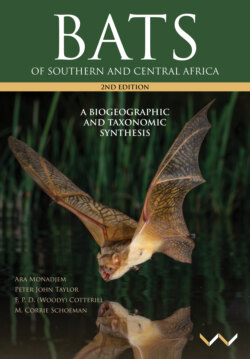Читать книгу Bats of Southern and Central Africa - Ara Monadjem - Страница 9
На сайте Литреса книга снята с продажи.
GEOGRAPHICAL SCOPE
ОглавлениеIn this book, we define southern Africa in its broadest, biogeographical context as the southern third of the continent, including a large portion of Central Africa. The book covers the southern African subregion, as well as all of Angola, Malawi, Zambia, Mozambique, and the southern portion of the Democratic Republic of the Congo (DRC). The northern boundary is set at 4°S; this line of latitude extends east to the western shore of Lake Tanganyika (Figure 2). This definition – pertinently the northern boundary at 4°S – extends the region recognised by previous workers, notably Ellerman et al. (1953) and Werger (1978), who placed a northern limit of 10°S on their studies of southern Africa. The syntheses of Smithers (1983) and Meester et al. (1986) were even more tightly restricted to the southern African subregion south of the Kunene and Zambezi rivers. Nevertheless, these treatments, including that of this book, all exclude the political region of East Africa, the main forest belt of the Congo basin, and the principal portion of the Albertine Rift.
Figure 2. Outline of the study area covered in this book: southern and Central Africa south of the bold line. It includes all of Angola, Botswana, Lesotho, Malawi, Mozambique, Namibia, South Africa, Eswatini (formerly Swaziland), Zambia, Zimbabwe and the southern half of the Democratic Republic of the Congo.
Within practical limits, the geographical scope of this synthesis of southern and Central African Chiroptera includes all known literature and museum records. So in addition to all the taxa known to occur throughout the southern African subregion, our biogeographical coverage incorporates important records for Central Africa. This includes the wealth of data compiled by Hayman et al. (1966), additional to Crawford-Cabral (1989) and Ansell (1978) for Angola and Zambia, respectively.
It is important to justify such a vast coverage, extending north of the southern African subregion to include all of Angola, Malawi, Mozambique and Zambia, and much of the southern DRC. Beyond incorporating bat faunas of the southwestern arid and southern savanna biomes, this coverage adds many bats that augment the region’s chiropteran diversity significantly. The occurrence of these interesting species reflects a key determinant of habitat, represented in the mesic savannas of the Zambesian phytochorion, and the Guinea–Congolia/Zambesia Transition Zone. These habitats dominate the vegetation of northern Angola and the southern Congo basin (White 1983). The biodiversity of the evergreen gallery forests is of special biogeographical significance, because of the high complement of Guinea–Congolian species (additional to local elements of Afromontane affinities); these forest-associated bats increase the overall diversity (see Biogeography for more detail and maps).
The pattern of occurrence of these Guinea–Congolian elements (including notable Chiroptera) exhibits a clustering in the landscape, because they are restricted to forest patches that form a mosaic in the encompassing savanna. This forest–savanna mosaic is structured along a latitudinal gradient. Its extent and composition reflects closely on the subcontinental trend in rainfall, which increases northwards; thus, the vegetation of south-central Africa grades from savanna in the south, through a savanna–forest mosaic, into the closed, high forests closer to the equator. Influences of this association between climate, landscape and vegetation on the biodiversity extend far beyond the main forest belt of the equatorial Congo, for even landscapes south of the Great Equatorial Divide (the Congo–Zambezi watershed, Dixey 1943) reveal its signatures; these are represented in the forested headwaters of the Upper Zambezi River and its main tributaries. Accordingly, the geographical scope of this book incorporates this forest–savanna mosaic, which dominates landscapes across so much of northern and central Angola, the southern Congo, and also a large portion of northern Zambia.
